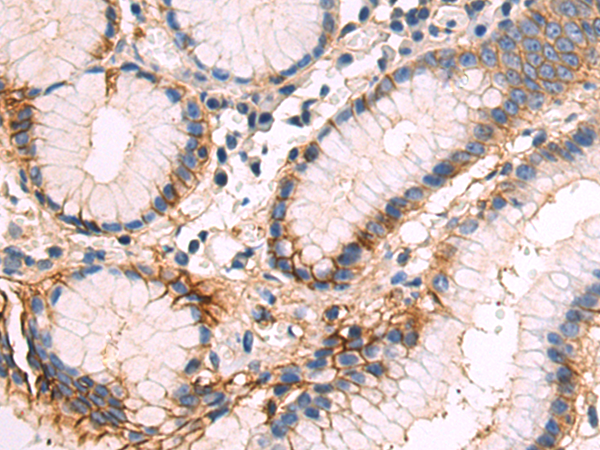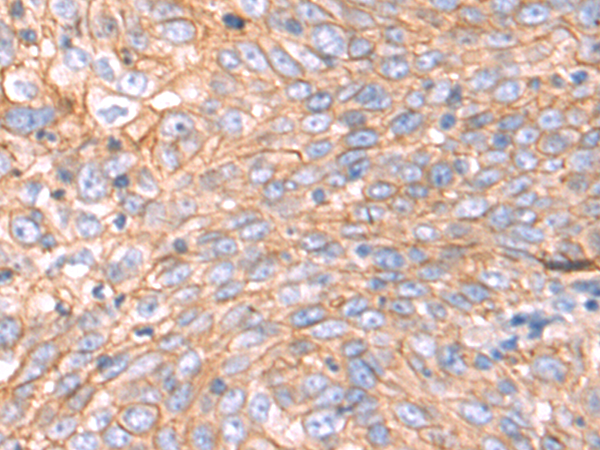


| WB | 咨询技术 | Human,Mouse,Rat |
| IF | 咨询技术 | Human,Mouse,Rat |
| IHC | 1/50-1/200 | Human,Mouse,Rat |
| ICC | 技术咨询 | Human,Mouse,Rat |
| FCM | 咨询技术 | Human,Mouse,Rat |
| Elisa | 1/5000-1/10000 | Human,Mouse,Rat |
| Aliases | EBS7; GP27; MER2; RAPH; SFA1; PETA-3; TSPAN24 |
| WB Predicted band size | 28 kDa |
| Host/Isotype | Rabbit IgG |
| Antibody Type | Primary antibody |
| Storage | Store at 4°C short term. Aliquot and store at -20°C long term. Avoid freeze/thaw cycles. |
| Species Reactivity | Human, Mouse, Rat |
| Immunogen | Fusion protein of human CD151 |
| Formulation | Purified antibody in PBS with 0.05% sodium azide and 50% glycerol. |
+ +
以下是关于CD151抗体的3篇参考文献及其简要摘要:
---
1. **"CD151 regulates tumor metastasis via integrin-mediated cell adhesion"**
*Authors: Zhang X.A., et al.*
摘要:研究揭示CD151通过与整合素(如α3β1和α6β4)形成复合物,增强肿瘤细胞粘附和迁移能力,促进转移。阻断CD151抗体可抑制体内肿瘤扩散。
2. **"CD151 modulates HCV entry into hepatocytes through EGFR interaction"**
*Authors: Tapia N., et al.*
摘要:发现CD151与表皮生长因子受体(EGFR)协同作用,促进丙型肝炎病毒(HCV)进入肝细胞。抗CD151抗体可阻断这一过程,提示其抗病毒治疗潜力。
3. **"CD151-dependent T cell activation and immunological synapse formation"**
*Authors: Fitter S., et al.*
摘要:CD151通过调控T细胞表面分子(如LFA-1)的聚集,影响免疫突触形成及T细胞活化。使用CD151抗体干扰该通路可抑制过度免疫反应,为自身免疫病提供干预思路。
---
以上文献均发表于《Cancer Research》《Journal of Virology》及《Blood》等期刊,涵盖肿瘤学、病毒学和免疫学领域。
CD151 antibody background:
CD151. a member of the transmembrane 4 superfamily (tetraspanins), is a cell-surface protein involved in cell adhesion, motility, and signaling. It interacts with integrins (e.g., α3β1. α6β4) and other tetraspanins to regulate cellular processes like angiogenesis, tumor metastasis, and immune responses. CD151's extracellular domain contains integrin-binding motifs, making it a target for therapeutic or diagnostic antibodies.
CD151 antibodies are tools to study its functional roles or block its activity in disease contexts. In cancer, CD151 overexpression correlates with poor prognosis, promoting metastasis via integrin-mediated extracellular matrix remodeling. Antibodies targeting CD151 have shown potential in inhibiting tumor growth and angiogenesis in preclinical models. They also aid in researching CD151's role in wound healing, kidney function, and infectious diseases (e.g., SARS-CoV-2 entry via tetraspanin-enriched microdomains).
Monoclonal antibodies (e.g., 5C11. 50-6) are commonly used to disrupt CD151-integrin complexes or detect CD151 expression in tissues. Challenges include ensuring specificity, as tetraspanins share structural homology, and optimizing antibody delivery for therapeutic use. CD151 antibodies remain critical for elucidating its pathophysiological mechanisms and exploring targeted therapies.
×